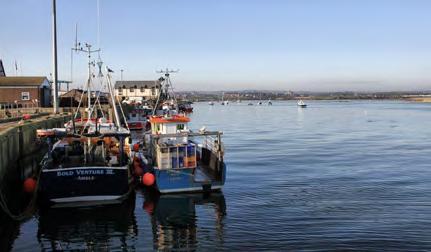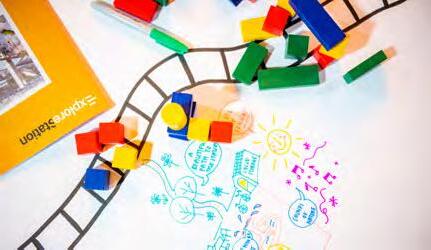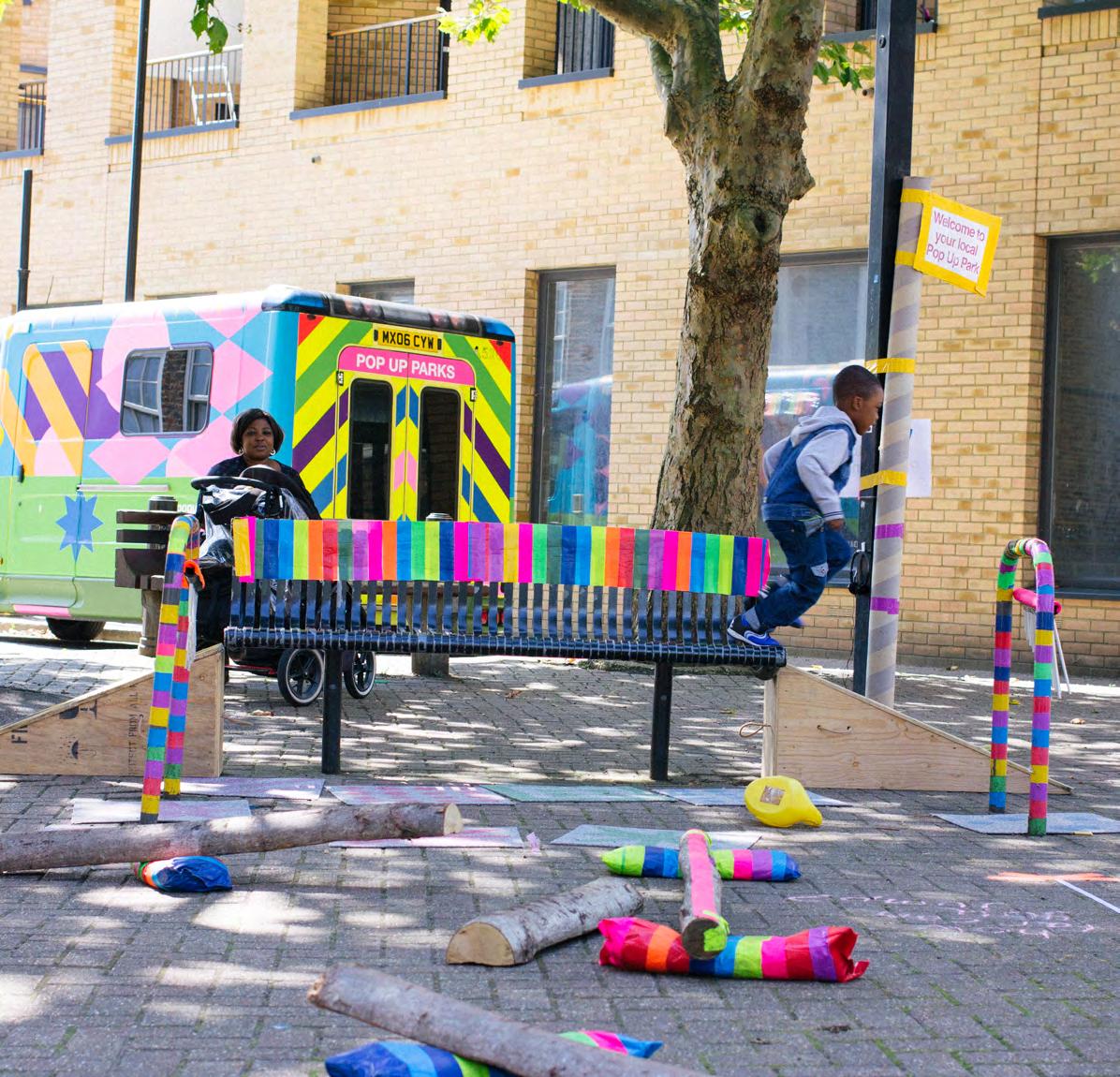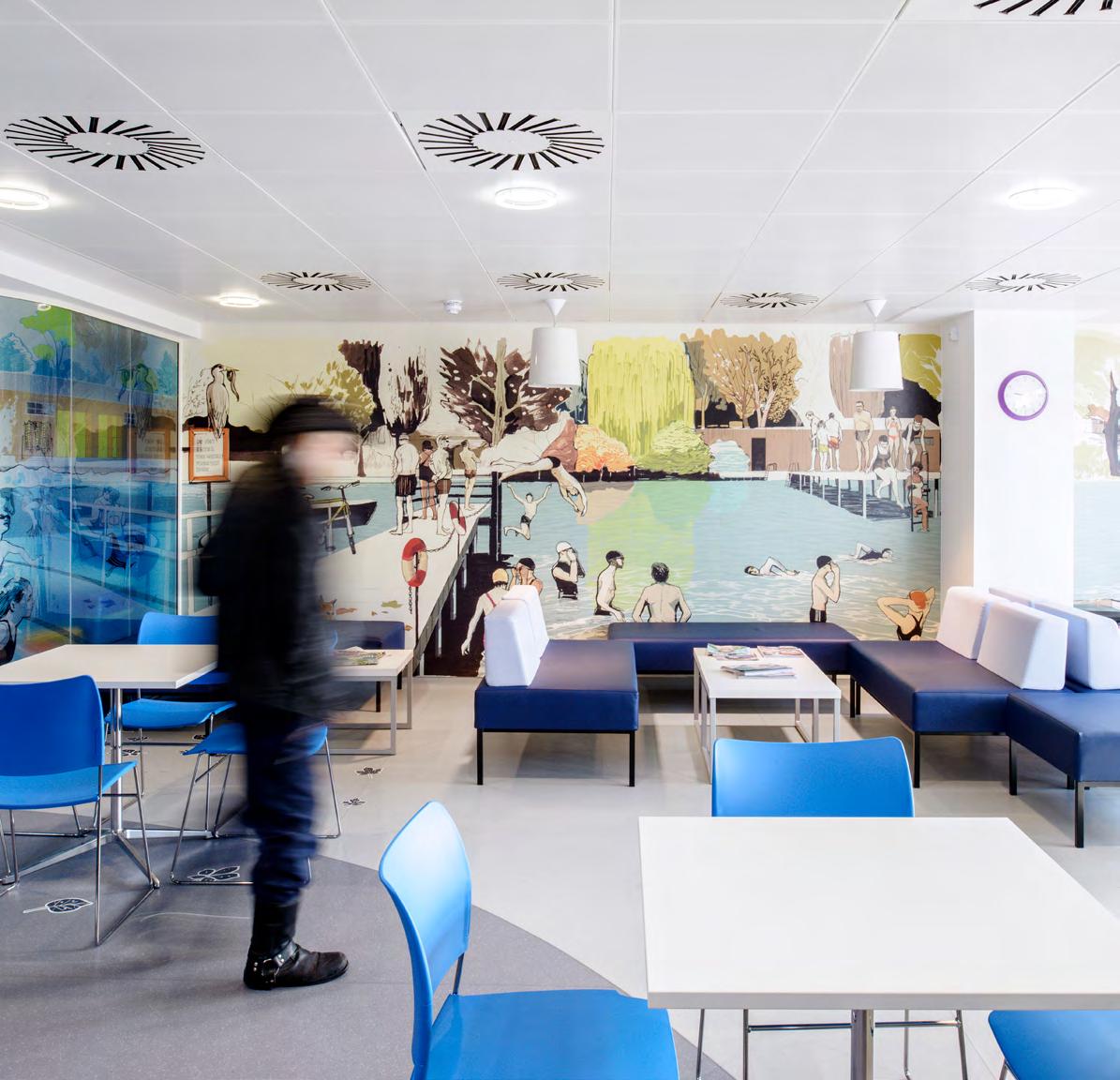Public Design Beyond Central
Government
Key Insights and Recommendations
2024/25

Key Insights and Recommendations
2024/25

Matthew Taylor CEO, NHS Confederation
Design adds significant value to public services, shaping how they are developed, delivered, and work with public, community, and private sector partners to help people and the planet thrive.
Over the last 30 years or so, design has taken root and grown within the UK public sector – from local councils and NHS systems and trusts to non-departmental delivery bodies across areas like housing, policing, and fire services. It began with early pioneers like the Social Innovation Lab Kent (SILK) launched in 2007 and gained momentum through the Design Council and the Local Government Association’s 10-year Public Sector Design Programme, which introduced design thinking to over 100 councils and NHS trusts. Today, design is firmly embedded in many parts of the local public sector, with organisations such as Camden Council now employing in-house policy designers.
In many ways, design is easier to apply at the local level. Services are delivered to and with local people every day, making it simpler to engage communities, understand their needs, and prototype and test improvements. Local settings also serve as testing grounds and feedback loops for the design of national policy.
Reflecting deeper challenges facing the nation as a whole, the UK public sector is under huge pressure. The coming period will almost certainly see real terms cuts in budgets across public provision. Already in key services, including the NHS, and specific areas – like special needs provision for children – the public is losing confidence and trust.
The danger is that design capacity is deprioritised, seen as a luxury that cannot be afforded. But this would be a mistake. Design is as important in hard times as in good. It is by applying design skills that we can work with the public to achieve better services and outcomes despite financial constraint. Design processes can and have been used to identify waste and progress improvements in productivity. There is a huge opportunity for design to do more, contributing to agile, focused, and more productive public services. To make services smoother, more efficient, and joined-up. To build trust and agency with local communities.
This report sets out what public sector leaders - both designers and non-designers - identify as the barriers and enablers to making this vision a reality. It explores what strong support at the local level could look like, and how to help it flourish: Strong design leadership; foundational design skills for all public sector workers; design teams embedded across organisations; processes for capturing evidence and sharing best practice; and stronger connections between designers across services and place, within both the public sector and commercial practice.
Design has been quietly infusing itself into the fabric of our public services and places. Let us now strengthen and celebrate it as the worldleading capability it is.
This report is an interactive pdf. This means you can click through to relevant sections of the report based on what you want to find out, rather than scrolling all the way through.
Use the page headers to navigate to different chapters and to click through the pages.
Click on this to go back to the contents page.
Click on this to go to another relevant section of the report.
For more information, please visit the design economy webpage
Please cite as: Public Design Beyond Central Government: Key Insights and Recommendations. Available online: Design Economy – Design Council.
This work is licensed under a Creative Commons Attribution-ShareAlike 4.0 International License. To view a copy of this licence, visit http://creativecommons.org/licenses/by-sa/4.0/
Since the 2000s, the use of design in the public sector has steadily grown. Design is now recognised as a vital tool for addressing complex societal challenges, improving governance, and enhancing public services. Today, 88% of the public sector say design plays a role in their organisation.
This report focuses on design outside central government—across local authorities, the NHS, the police, emergency services, and other bodies. It draws on a 2022 survey of 1,018 public sector employees, conducted as part of the Design Council’s Design Economy research, and two participatory workshops with 32 public sector design leaders in 2023/2024.
Our findings informed the UK Civil Service’s 2025 Public Design Review, a once-ina-generation review of design in the public sector.
The Design Council has a long-standing history of assessing the use, impact, and value of design in the public sector and supported capability building. Case studies from partnerships with e.g. the Local Government Association, Network Rail, and the NHS informed this report’s recommendations.
The value and practices of design today
Design offers citizen-, community-, and user-centred ways of developing policy, delivering services, and shaping places. It is used more strategically in the public sector than in the private sector: 31% of public sector respondents say design
is integral to strategy (compared to 22% of private sector respondents).
Design delivers value across three areas:
People. Enables co-production and citizen involvement; takes a user-centred approach that meets real needs; and empowers communities by ensuring change is done with, not to them.
Organisations. Promotes more efficient, joined-up, and innovative public services; supports shared vision-setting; and enables better collaboration across departments and systems.
Systems and places. Encourages systems thinking and prevention, addressing root causes instead of reacting to crises. Place-based design reshapes how people engage with services and their environment.
Most design in the public sector is delivered by non-experts using design tools like user research, journey mapping, and prototyping. While 58% say design is part of their role, only 13% identify as experts. This democratisation is valuable, but stronger expert leadership is also needed.
To unlock greater value, design must become a core public function with mature structures that can transform organisations.
A future public sector shaped by design would include:
Design leadership at every level, including Heads of Design.
Consistent public involvement in service, place, and policy development through high-quality co-design.
Widespread design literacy among everyone working in the public sector.
A recognised public design profession with valued specialist roles.
Integrated design teams embedded across departments and strategy.
Strong collaboration between local and central government.
Infrastructure to support quality design—data, governance, procurement, and skills development.
Challenges remain. Design is not yet treated as a core business asset. Fixed organisational processes (28% of survey respondents see this as a key barrier), risk-adverse cultures (23%), and a lack of senior design leaders and champions (28%) stifle progress. Budgets for design are falling (25%) and technical design skills are limited (19%).
Although enthusiasm for design is high, it is not yet matched by investment, skills, or leadership.
1
The focus for the next stage of public design’s development should be coherence, unity, and quality. Our key recommendations hence are:
01. Strengthen design leadership. Establish senior roles (e.g. Chief Design Officers) across public bodies to grow organisational design capability.
02. Build a public sector design community. Create events, tools, and training to connect diverse design practitioners and champions across disciplines to address public missions like the Climate Crisis.
03. Pilot better design practices. Test structured approaches like Design Review panels, shared design principles, and boardlevel champions.
04. Improve design procurement. Develop open frameworks and support local authorities to engage local design firms and ecosystems.
05. Develop a design accreditation and competencies framework.
06. Grow the talent pipeline. Reform design education, strengthen links with higher education, and develop apprenticeship and secondments. Promote ‘green’ design skills to help address the Climate Crisis.1
The Design Council, as the UK’s national champion for design, has supported the development of public design for over 20 years. We will continue to partner with the public sector to implement these recommendations—creating better outcomes for people, public finances, and the planet.
Since the turn of the millennium, the use of design in the public sector has grown significantly, with 88% of public sector organisations now recognising its role. Design is not confined to aesthetics or product development; it is an essential tool for solving complex societal challenges, improving governance, and enhancing public services. This report explores the impact of design beyond central government, examining its application in local authorities, the NHS, the police, emergency services, and other public sector bodies.
Research has shown that design-led approaches foster innovation, enhance service delivery, and create more responsive public policies. The Design for Europe project mapped nearly 150 organisations applying design in the public sector, demonstrating its widespread adoption across different nations. In the UK, initiatives such as the Government Digital Service and the Policy Lab have shown how design thinking can transform policymaking and service provision. Design is also deeply embedded in urban planning, with a growing convergence between physical and non-physical design disciplines in shaping public spaces.
Against this background, the UK Civil Service has undertaken a once-in-a-generation review of design in the public sector, aiming to establish how public design generates public value. Supported by the Arts and Humanities Research Council (AHRC), the Design Council convened public sector design leaders to inform this Public Design Review and to shape its recommendations.
We held two workshops for design leaders from local authorities and the wider public sector beyond central government. Participants came from policy, service, strategic, interaction/digital, urban and infrastructure design. They shared case studies to examine the value created by design, identified and explored barriers to public design, and helped shape key recommendations. This document summarises insights from both sessions and identifies key recommendations to feed into the Review.
In addition to these workshops, the Design Council conducted a survey of 1,018 public sector employees across the civil service, local government, and public sector organisations (such as the NHS and police services) as part of its Design Economy research programme in 2022. The survey was conducted by YouGov and was live from 11th to the 27th of February 2022. Its focus was on the use and understanding of design in the public sector, complementing other Design Economy research studies on the economic as well as the environmental and social value of design, and a similar survey within the private sector.
The Public Design Review presented a unique opportunity for us to leverage our Design Economy data for a pressing, high-profile purpose. By integrating insights from our research, we were able to provide a robust evidence base demonstrating the value of design in the public sector. This work allowed us not only to reinforce the importance of design in policymaking and service delivery but also strengthened connections to our diverse Design Council programmes.
By aligning these efforts, we aim to highlight the role of design as a driver of public value, linking it to wider discussions about economic, social, and environmental impact.
Survey findings are presented throughout the report, while examples of our past projects and programmes, illustrating the benefits of design practices in real-life contexts, are included in the next section.
The data from our survey shows that just over half (58%) of respondents use design as part of their role whilst a significant majority of the public sector organisations use design (88%), and almost a third use it at a strategic level.


Many participants emphasised how design enables more systemic approaches to public challenges and supports preventative interventions. This is particularly important where design informs large-scale, capital projects such as investment into the built environment or infrastructure. These interventions sometimes take a distinctly place-based approach, bringing together multiple stakeholders to design and deliver an intervention to affect whole systems change around a local place or community.
Survey results show that design is more likely to play a strategic role within the civil service (42%) compared to non-central government (28%). However, design is more likely to be integral to service and policy improvement and delivery outside central government (60%) than within it (49%). This suggests that policy design outside of central government is more focused on delivery.
Workshop participants described design practices as follows:
Facilitating co-production and citizen involvement in policy and service development is essential for creating inclusive and effective solutions. Design frameworks provide structure for purposeful and sustainable community engagement and co-production. They also help public sector teams engage with users in a ‘safe’ way, reducing reputational risk.
This approach enhances public value by ensuring services and policies are wellsuited to community needs. It also creates social value for co-design participants and strengthens democratic engagement. According to the survey, 61% of respondents are already using—or planning to use— design to make policy and service design more inclusive, accessible and democratic.
User-centred approaches give a realistic understanding of public needs and behaviours. This enables the public sector to create the right solutions rather than forcing a pre-determined, solutions-first approach. Participants highlighted design’s value in being ‘responsive to needs of beneficiaries’, ‘amplifying user experience’, enabling ‘empathy of lived experience’, and ‘exposing different viewpoints and conflicts’.
A related but distinct benefit is growing community agency. Involving people in the process—ensuring change is done with rather than to people—and empowers citizens to take an active role. When people are involved in shaping solutions, the resulting product, space, or service is not only likely to be a better fit for their needs but also more likely to be embraced by the community, ensuring longterm impact. According to the survey, 54% of respondents are already using—or planning to use—design to increase people’s autonomy and dignity.
Creating more joined-up, efficient, and innovative approaches. Design is being used to create shared visions and strategies across different services and directorates within public sector organisations, facilitating larger scale and more effective collaboration. Design builds public sector organisations’ confidence in testing, experimenting and establishing new ways of working. A design approach helps avoid duplication and find open space for more innovative approaches.
Enabling cross-organisation engagement and creating more connected systems for citizens. Design fosters collaboration across public sector organisations, helping to align goals and build consensus. This leads to betterconnected systems that provide streamlined, integrated services, increasing social value by making it easier for citizens to access what they need.
Taking a systems view and foregrounding prevention. By exploring challenges within their broader context, design helps to identify the right problem to solve rather than just addressing symptoms. This systems-thinking approach 2 enables preventative, upstream interventions, reducing the risk of problems being displaced elsewhere. Participants highlighted design’s ability to ‘address issues before crisis point’ and ‘improve understanding of the systems we work in’.
Taking a place-based approach. Many designers emphasised the importance of a place-based approach which focuses on how people interact with multiple services and environments within a location.
Workshop discussions focused more on common design approaches rather than specialised design skills like drawing, modelling and visualising. This may reflect the background of participants or indicate a shift as design becomes more widely practiced by non-experts. A key question remains: Are specialised design skills becoming less common or less valued in public sector work? Further research could explore this trend.
While not discussed by participants in the workshop, 74% of survey respondents said they were, or plan to, use design to become a more digital organisation. Digital transformation and public sector use of design are clearly linked.
2
We can group the outcomes described by workshop participants into key areas, recognising the complexities of linking practices to outcomes. These outcomes go beyond primary project objectives and highlight the broader value of the design process and its implementation.:
Better value for money and efficiencies. Early and systemic interventions through design save money and ensure costs are not simply shifted elsewhere. A test-and-learn approach enables errors to be spotted and addressed early, increasing effectiveness of interventions and saving money in the longerterm. 44% of survey respondents understood the purpose of design to improve effectiveness and efficiency, and 44% were already using design to achieve efficiencies with a further 28% planning to by 2025.
Reducing risk. Design helps minimise financial and reputational risk by ensuring a deep understanding of needs and testing interventions early and cost-effectively. This leads to more informed decision-making and reduces wasted resources. As one participant put it: “There’s no greater waste of public money than to have the best solution to the wrong problem.”
Building internal capabilities. Involving non-design colleagues in design processes helps upskill teams and strengthen internal capabilities. In the 2018 review of LGA & the Design Council’s Design in the Public Sector programme, 93% of participants reported sharing the design approaches they learned with immediate colleagues.
Less siloed organisations and services. Design processes help break down internal siloes by using insights from service delivery and operations to inform policy design and upstream decisions.
Increasing public confidence. When services and systems are designed with communities, they better meet people’s needs, leading to greater trust and confidence in public institutions.
Driving new business and revenue streams. By identifying opportunities, design helps organisations generate new income and create sustainable business models.
The Design Council regularly supports public sector organisations to embed effective use of design, helping to realise improved policies and services. Working with the Local Government Association on Design in the Public Sector, we have supported more than 90 local authorities to apply design methods to challenges spanning public health, housing, and the Climate Emergency. Programmes, such as the Employee Health and Innovation Fund, delivered in partnership with Impact on Urban Health, have supported organisations to use design to develop more effective working practices. The following examples demonstrate, in varied contexts, how design practices can lead to better outcomes.
Co-production helped Northumbria County Council to ensure that the redevelopment of Amble, a historic fishing port, was beneficial to the community.
The 2010 closure of Amble’s largest employer resulted in the loss of 250 jobs and left a major industrial site vacant. With the Amble Development Trust, the local Council enlisted the Design Council’s support to cocreate a new service model for the site.
Design Council Associate Nick Devitt led workshops with local stakeholders, including businesses, the tourist board, and the police to explore ideas. The group co-created a vision to transform Amble into a foodcentred tourist destination, including retail pods for local producers and a seafood centre.
In 2012, with greater community agency, local stakeholders published Amble 2020 which outlined plans for regeneration. In 2014, the town secured £1.8m from the Coast Community Fund which enabled new retail pods and a seafood centre to open, creating jobs, and boosting tourism. In 2015 Amble was crowned Highstreet of the Year.

Design enabled Staffordshire County Council to take a user centred approach to improve services for vulnerable children.
In Staffordshire in 2014, over 40% of children on Child Protection plans were under the age of five. Through Design in the Public Sector, Staffordshire County Council collaborated with Spark CIC, a communityrun children’s service, to explore more effective ways of engaging vulnerable preschool children.
Design methods, including engagement with ‘super-users’, non-users and service providers, helped uncover that the local Council’s free pass scheme unintentionally created stigma, and their funding mechanism failed to incentivise Spark CIC’s engagement with ‘at-risk’ families.
The team redesigned Spark CIC’s service by introducing a family membership card, visually the same for all families, and moving to a reimbursement funding model based on attendance data. This led to a nearly 300% increase in participation hours and successfully engaged 155 ‘hidden’ children.

Supported by the High Streets Task Force, Ellesmere Port, in Cheshire, took a place-based approach to improve the connectivity of the town’s cultural sites and leisure spaces.
Design Council led shared visioning workshops, bringing together stakeholders from the local authority, businesses and elected bodies to identify the town’s successes and challenges and consider joined-up approaches to find solutions.
The group recognised Ellesmere Port’s strong retail offer and proximity to cultural sites and parks but noted poor links and integration of cultural activities. Prioritisation exercises helped them to develop ideas and consider their potential impact and relative difficulty. The local stakeholders felt they could achieve successful community-led interventions around a new cultural strategy and by rethinking the use of the Civic Square.
With further support from the Highstreets Taskforce Ellesmere Port have begun to implement various interventions. This includes the development of nearby Whitby Hall into a world-class centre for arts and culture that has helped to increase footfall by up to 30%.

In 2020, Transport for London’s (TfL) occupational health department reconsidered their employee wellbeing services to foreground prevention and mitigate the risks of long-term health conditions among their 19,000 operational employees. TfL joined Design Council’s Employee Health and Innovation Fund Programme after their health check data revealed that over 20% of employees were referred to their GP for high cholesterol, high blood pressure, or mental health concerns.
Design Council Experts supported a cross-organisation team to use design methods such as user research, opportunity reviews, visioning, and prototyping. The team discovered that many employees had negative perceptions of the occupational health department and struggled to fit appointments into their work schedules.
Building on this, a mobile health unit was trialled, conducting 412 health checks across seven locations and a communications project reframed the department’s role. The programme had a lasting impact on the team, the Head of Occupational Health acknowledging they are “nowmorelikely tothinkofwhatotherdepartments[they] can work with”. Additionally, they began to see a positive shift in employee perceptions: “Having TfL provide a 45-minute health check is invaluable to my health”.


The survey provides key insights into the use of design across disciplines and applications: 59% of respondents are already using—or planning to use—design to improve spaces and places for people. 71% are applying design to services and processes, a significant practice in the public sector.
While nearly half (47%) of respondents reported having an in-house policy designer, only 19% had an in-house architecture and built environment professional. Service design is most prominent in local government, with 50% of respondents stating they have an in-house service designer.
Although the workshops did not focus on specific disciplines outside central government, two key reflections emerged from the discussion:
The public sector relies heavily on non-expert designers: while only 5% of the workforce are professional designers, 20% use design in their roles. 58% of respondents incorporate design into their work, but only 13% identify as experts.
Workshop participants highlighted the role of non-expert design champions—professionals who apply design methodologies without formal training. As generalist design approaches become more widespread, the role of specialised disciplines like graphic design, UX, and architecture—which typically require formal training—may shift. Balancing specialised design skills with the increasing use of generalist design approaches will be key to public sector innovation.
The values and practices of design identified in the workshop had remarkable consistency across diverse design types/disciplines. Interestingly, outside of central government, place and the physical design of urban spaces and infrastructure appears to play an integral role in policy and service design and delivery.
This suggests that urban design is more integrated into public sector work than often assumed, particularly outside central government.
For example:
Secured by Design (a crime-prevention policy) integrates policing, local government, and urban design to reshape physical spaces. 3

Network Rail improves accessibility through a combination of physical, service, and policy design. 4

The High Streets Task Force uses design thinking to create strategic urban visions for UK town centres. 5

3 See Secured by Design - Secured by Design (last accessed 02 April 2025).
4 See e.g. NR_Design_Council_Value_of_Design_Report.pdf (last accessed 02 April 2025).
5 See Home | High Streets Task Force (last accessed 02 April 2025).
In the second workshop, participants were asked to visualise what public design would look like in 2035, if the Public Design Review led to a transformative shift in how design is used. The key elements were:
Strong, multidisciplinary design leadership is visible everywhere. A diverse set of designers hold leadership roles. At every city/regional level, there is a Head of Design. Non-design leaders commonly advocate for and build in capacity for design within their organisations. The new generation of local government leaders and chief executives see design as a key skill.
Design brings the public into service and policy development.
Co-design is used as a standard practice for developing ideas across organisations. Co-design with citizens and communities is the norm, and design is used to share power. It helps create more human-centred public services and policies that develop community agency.
All public servants can think like a designer.
Everyone working in the public sector has foundational design thinking skills and design literacy, enabling them to do better work. Specialist design skills and crafts (like graphic design, and UX design) are valued and supported.
Public servants test and iterate confidently. Testing and iteration are built into project plans, with much more resource invested in the problem and ideation phase. Design is more strategic and less reactive. Because projects are properly framed and positioned early on, costs for projects are significantly reduced.
Design is an established profession in all public sector organisations – similar to research today.
Design has moved from siloed teams, to being embedded across whole organisations. Design practice and designers are woven throughout organisations and involved in the framing and re-framing of projects and strategy at all phases. Multidisciplinary design approaches are much more commonplace; boundaries between government capabilities are blurred. Design-led approaches are consistently part of the toolkit for the complex social challenges citizens face.
Design is better used ‘upstream’. Design shapes and informs policies more powerfully and consistently from the start. The focus is on prevention. Design is not simply used to improve the status-quo but applied with bold vision.
There is a strong connection between local and central government, enabling much better implementation of design. There is a close, reciprocal relationship between central and local government. Design ideas, capabilities, insights and implementation flow better between the two. A policy developed by central government is prototyped and iterated by local government. Central government develops a fit-for-purpose system for devolving design work to local governments, and local governments invest in their design capabilities at a higher strategic level accordingly.
Data and evidence underpin the growth and impact of design.
Design research and data collection evidence the value of design, design’s demonstrable impact underpins its growth in the public sector. Data-driven insights into user needs are used well. Organisations share data and research findings to create a collective understanding of citizens’ needs and behaviours. Emerging technology such as AI is used to model, test and report back on design ideas.
There are established systems and governance mechanisms to ensure design quality.
All projects, delivery, services, and policies have a Design Review (or design crit) embedded, follow an established design process and common set of standards. A strong set of embedded design principles transforms the DNA of public sector organisations – for instance, people are trained in them during onboarding. A wrap-around change management capability embeds and continuously improves design.
All procurement reflects the value of good design.
Procurement teams have high levels of design literacy. The procurement process is more open and based on an alliance-contracting model, where stakeholders come together to give feedback on the brief, ensuring its fit-for-purpose early on.
There is consistent capacity building support for design, the right tools are readily available.
Design skills and capability building programmes, such as LGA’s Design in the Public Sector, are funded consistently by government, growing the quality and confidence of design. Designers have access to the tools they need to do their best work.


The Design Council’s survey and evaluations of past public sector programmes have provided valuable insights into the barriers, enablers, and opportunities for design within the public sector. Over the past decade, our research has consistently shown growing interest and adoption of design approaches. However, design is still not recognised as a core business function, and institutional barriers continue to hinder its long-term success.
Design’s generative and exploratory approach to delivery is often at odds with standard public sector processes – for instance, the need to define fixed outputs at the start of a project or complex sign-off processes for public engagement. 31% of all respondents listed this as a barrier in our 2022 survey – within the civil service, it was 41% and outside central government, 28%.
Rigid decision-making processes in organisations leave little room for refinement or iteration. This issue is worsened by procurement and contracting practices that focus on outputs over outcomes, limiting budgets for design-driven work.
Data protection processes can limit the level of community engagement, collaboration and peer learning, preventing designers from those they most need to serve.
Mismatch between local and central government design approaches: Central government follows the Government Digital Service approach, while local government develops customised design solutions, making it difficult to share and scale innovations.
Design is seen as a risky approach to creating and delivering public services. Involving people more closely in decisionmaking can make organisations feel vulnerable. This is a greater concern in the civil service (30%) than in non-central government (23%).
Resistance to co-design stems from a lack of evidence demonstrating its value case for using co-design approaches in the public sector which can lead to unexpected outcomes and radically reframed briefs.
There is a lack of flexibility around how design is commissioned, including difficulties hiring trusted, senior designers and portfolio managers equipped to manage and mitigate risk proactively.
When senior leaders actively support design, it thrives. Awareness of design’s value is higher in the civil service (52%) than in local government (47%) or the NHS (37%). However, 28% of respondents in a 2022 survey identified leadership awareness as a barrier.
Leaders are measured on outputs, not outcomes, discouraging them from using design early in projects where it can be most impactful. Instead, design teams are forced to reframe problems later, leading to expensive project pivots.
Leaders are often disconnected from end users, making decisions based on second-hand information rather than first-hand experience of community needs.
The broad definition of ‘design’ makes it hard for non-designers to grasp the diverse ways it can be used. For example, leaders often struggle to understand the distinct value of service design compared to more tangible outputs.
Budget constraints are a significant issue for local government, where 21% of design budgets have decreased over the last five years, compared to 16% that have increased. In contrast, civil service budgets are more likely to have grown. A quarter of survey respondents cited funding limitations as a key barrier.
Compressed timelines: Limited budgets force shorter project cycles, reducing time spent understanding problems—a critical part of the design process.
Limited access to talent: Training non-designers and hiring experienced professionals is difficult with tight resources. External commissioning is also restricted, making it harder to build long-term design infrastructure.
Design is both a generalist capability –something most people can be taught to apply – and a specialist and technical skill. 60% of survey respondents said design vacancies are more difficult to fill now than five years ago, citing poor terms and conditions, few applicants, and high competition.
19% of survey respondents working outside of central government listed limited access to people with technical / professional design skills as a key barrier, compared to 9% within the civil service. This may indicate smaller, more generalist design teams are more common outside central government, without the resources to hire or procure specialist design skills.
No established training route exists for design and designers in the public sector. While apprenticeships are emerging, they are not yet widespread. Integrating design training into public sector development programs is crucial.
Over-reliance on external commissioning prevents in-house skill development and often results in lowerquality, less context-aware solutions.
In-house design teams are stretched, and private sector salaries outcompete public sector pay, making it harder to attract top talent.
Diversity and equity in the sector remain a challenge: Public sector design teams do not always reflect the communities they serve. Expanding access to design careers and ensuring equitable workplaces is essential.
Procurement seems to be a bigger challenge in central government. 22% of central government respondents cited lack of confidence procuring design as a barrier, compared to 13% outside central government. This suggests that outside central government, design capability gaps are more linked to in-house skills shortages than difficulties in working with external contractors.
Limited understanding of design in procurement teams: Poor knowledge leads to ineffective procurement or no design procurement at all, increasing project costs when work needs to be reoriented later. More co-creation upfront is needed to ensure procured work is fit for purpose.
Procurement prioritises outputs over outcomes: Current processes conflict with design’s role in challenging and reframing project briefs. Existing procurement restrictions need reform to allow more flexibility.
Design is often seen as ’gold plating’ in a project: It is often one of the first things to be cut, leaving design teams without the time or resources to drive meaningful change. This stifles experimentation and innovation.
Within the civil service, lack of confidence, motivation, and opportunities to use design were seen as key barriers. However, these factors were less significant in the wider public sector, where there is clear interest and willingness to use design.
The real barriers are structural, embedded in leadership models, organisational processes, workforce skills, and investment patterns. To unlock greater public value, these deep-rooted systems need to shift, allowing design to play a stronger role in shaping effective public services.
In conclusion, we propose the following recommendations for the ‘Public Design Review’ and beyond, ensuring they reflect the experience of those leading design work outside central government.
Public sector organisations should establish Chief Design Officers or senior design champions to oversee and develop design practice. These leaders should have access to subsidised training and knowledge-sharing events that focus on real-world challenges, with impact measured over 3–5 years.
Context: Leadershipisakeyenablerfor embeddingdesign.Currently,only40%of publicsectororganisationshaveadedicated designdecision-maker,comparedto63%in theprivatesector.Executivedesigntraining pilots,suchasNetworkRail’s,highlightthe impactofseniorbuy-in.
A structured portfolio of events, training, and resources should connect public sector designers. This should include:
Access to trusted design frameworks and tools.
Cross-disciplinary events, including an annual public design festival.
Training for both practitioners and leaders to apply design in addressing public challenges like climate change.
Context: Publicsectordesignersoftenwork inisolation,withlittlealignmentacrosslocal authorities.Acentralnetworkunitingdifferent designdisciplinesisneededtostrengthenand sustainpublicdesignpractices.
A series of 3–5 pilot initiatives should be funded and evaluated to define and improve design quality in public services. Lessons from urban design policies, such as Design Review Panels, could be adapted for public services and digital systems. In the built environment context, where Design Review is an established practice, it could be strengthened through the creation of a National Design Review Framework.6
Context: Establishedmechanismslikedesign codingandreviewpanelshaveimprovedurban designquality.Applyingsimilarapproaches toservices,policies,andsystemscoulddrive betterpublicsectordesignoutcomes.
6 See Design for Neighbourhoods by Design Council (last accessed 02 April 2025).
The government should develop a framework agreement for service and policy design agencies, making it easier for public sector organisations to access specialist design expertise. The framework should include:
Outcome-focused tender templates. Resources for community engagement. Guidance on supplier collaboration and secondments.
Monitoring and evaluation tools to build evidence for design’s impact.
Context: Effectiveprocurementunlocks higher-qualitydesignwork.However,existing policiescreatebarriers,andthereisoftena disconnectbetweenpublicandcommercial designecosystems.Astructuredframework wouldenablefaster,betteraccesstodesign talentwhilesupportinglocaldesignindustries.
The Civil Service has begun developing an accredited design training programme for in house designers and professionals using design thinking across all disciplines. This work should continue to be rolled out, furthering an accreditation system for design training providers, complemented by a cross disciplinary competency framework to help structure professional development and ensure consistent, high-quality training.
Context: Manypublicsectorprofessionalsuse design,butinconsistenttrainingcanleadto misapplicationofdesignmethods.Aquality markfortrainingandaclearcompetency framework would build confidence in investingindesignskills.
To grow design capacity, the public sector must focus on both generalist and specialist design skills:
Generalist level: Revive Design & Technology education in schools and integrate design challenges into other subjects.
Specialist level: Strengthen connections between design schools and public sector careers, including graduate schemes, apprenticeships, and secondment opportunities.
Context: Thepublicsectorneedstopdesign talent in-house. More structured and visible careerpathwayswillimproverecruitmentand retention,ensuringdesignplaysacentralrole inshapingpublicservices.


The following people contributed to the development of this research, either through participating in the workshops or contributing to the research analysis.
Alejandra Diaz Head of Policy and Service Design, London Borough of Camden
Allison Savich
Strategic Lead Innovation & Digital, Sport England
Almira Lardizabal Hussain
Principal Policy & Programmes OfficerInnovation & Collaboration, Greater London Authority
Andrew Knight Head of UK Policy Design Community
Andrew Elliot Head of Change, Leicestershire Police
Anna Mclean
Director of Engagement and Innovation, Loch Lomond & The Trossachs National Park
Anthony Dewar
Professional Head of Buildings and Architecture, Network Rail
Aurelie Lionet
Senior Service Designer, Futurice
Beatrice Fraenkel NED, Stockport NHS Foundation trust
Catherine Howe Chief Executive, Adur & Worthing Councils
Ellen Vernon Programme Director, One Public Estate, LGA
Flora Newbigin Head of Knowledge (interim), Design Council
Gemma Bone Dodds Scottish National Investment Bank
Hannah Scothern Senior Associate, PwC
Helen Spires Interim Head of Design, DWP Digital
Ilse Bosch Deputy Director, Policy, NHS Confederation
Jake Sumner Senior Policy Advisor, Birmingham City Council
Jessie Johnson Head of Knowledge, Design Council
Jonathan Rez Head of Service Design, Bank of England
Jonathan Lloyd Corporate Director of Strategy and Change, London Borough of Waltham Forest
Laura Smart
Director - Behavioural Hub, Competition and Markets Authority
Nick Kimber
Director of Strategy and Design, London Borough of Camden
Natasha Bhambhra Senior Manager - Service Design, EY Seren
Nayna Tarver Policy Advisor, OFGEM
Noel Hatch Assistant Director for People and Change, Adur & Worthing Councils
Paul Thurston Design Director, EY Seren
Sadie Morgan Chair, National Infrastructure Commission
Serena Nüsing Senior Service Designer, Policy Profession
Shagun Seth Director, Local Public Services, EY Seren
Simon Parker Director of Strategy, South Gloucester Council
Simon Woods Accenture
Sophie Dennis Head of User-Centred Practice, Made Tech
Tero Vaananen Head of Design, NHS England
Will Steggals Head of Strategic Delivery, The Crown Estate
Matilda Agace Bronwen Rees Cat Drew Dr. Irene Hakansson Josephine Ryan Gill
Joana Pereira
– Mitchell Johnson via Unsplash (page 11).
– Amble, Northumberland. Credit: Pixabay (page 16).
– Alexandr Podvalny via Unsplash (page 16).
– Street Engagement. Credit: ImaginePlaces (page 17).
– Transport for London TfL Well Van. Credit: Steve Bell (page 17).
– Future of Service Areas Workshop 2. Credit: Design Council (page 18).
– Van Gogh Walkway. Credit: Surrey County Council (page 20).
– ExploreStation. Credit: Design Council (page 20).
– ImaginePlaces (page 20).
– Pop up parks project. Credit: Robin Howie at Fieldwork Facility (page 24).
– AMC Waiting Area. Credit: Jill Tate via Whittington Hospital (page 31).